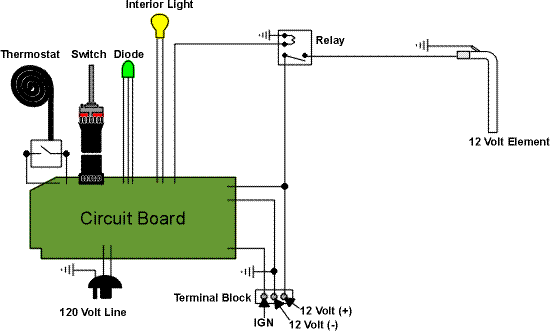Dave's Place
Dodge Motorhome Manual Information
Before working with electricity, visit the electrical safety page.

The 12 volt heat element pulls very high amperage. A 325 watt, 12 volt element (the largest used) pulls 23 amps. Even the smaller models pull relatively high amperage. For this reason, the AES system is designed to use the 12 volt heat element only when the vehicle engine is running and therefore charging the battery. To accomplish this, a third terminal (the IGN terminal) is added to the terminal block.
The wire from the RV connecting to the IGN (ignition) terminal of the refrigerator should be wired in such a way that 12 volt positive (+) is supplied to the terminal when the vehicle engine is running and only when the engine is running. An on/off switch may be added to this line somewhere in the RV to eliminate the 12 volt heat element as a possible heat source when desired. Disconnecting the wire from the IGN terminal will permanently disable the 12 volt heat element as a possible heat source. Sometimes the 12 volt heat element, plus a few vehicle batteries is too much for the vehicle alternator.
When 12 volt is present at the IGN terminal, wired straight to the circuit board, the 12 volt heat element is the second choice of the circuit board for a heat source (after 120 volt). If 12 volt is not present at the IGN terminal, the 12 volt heat element is skipped over as an option. When the conditions for 12 volt operation are met, the circuit board sends 12 volt positive (+) to the number 86 connection of the 12 volt relay to activate it. When activated the points inside the relay snap shut and provide 12 volt to the 12 volt heat element directly from the 12 volt (+) terminal of the terminal block. Using the relay makes it unnecessary for the high current flow to the element to pass through the circuit board.
When the vehicle is turned off and 12 volt to the IGN terminal is discontinued, the circuit board begins a 20 minute delay before lighting the gas side of the refrigerator (if lighting the gas side was the next normal sequence). This is to eliminate a possible hazard when the RV stops at a gas station. You can over ride this delay by turning the refrigerator off for about 15 seconds and then back on.
Troubleshooting DC Operation
The first step in troubleshooting 12 volt operation (12 volt as a heat source) is to check the IGN
terminal of the terminal block for 12 volt positive (+), when the vehicle engine is running. If it
isn't, correct the problem. Before we continue, we need to assume that 12 volt heat operation is
the only problem with the refrigerator and that the thermostat is calling
for cooling. If this isn't true, correct the other problems first. Next, locate the connection
between the 12 volt heat element and the rest of the system (this could be a plug in or a direct
connection to the 12 volt relay and ground). Check for 12 volt at these connections. If 12 volt
is present and the heat element does not get hot, the element is bad. If there is no 12 volt to
the heat element, check for 12 volt at the number 86, 87 and 30/51 posts of the 12 volt relay.
If there is power to post 86 and 30/51, but not 87, the relay is bad or there is a connection
problem. No voltage at the number 86 post means the circuit board or connections to the circuit
board are bad. No power at the 30/51 post is a connection problem.
Sometimes there is nothing visible wrong with the circuit board, but still you strongly suspect it is the problem. If you can find an RV repair shop near you with a board tester, take the board to them and they will probably test it for free.
Dometic AES System
RV Refrigerator Home
This RV refridgerator information was originally located on rvmobile.comRV Mobile Inc. 11715 HWY 99, Everett, WA 98204
The owner of RV Mobile Inc. apparently suffered a heart attack and the original website was shut down.
It has been reposted here to preserve this wealth of information RV refridgerator information.